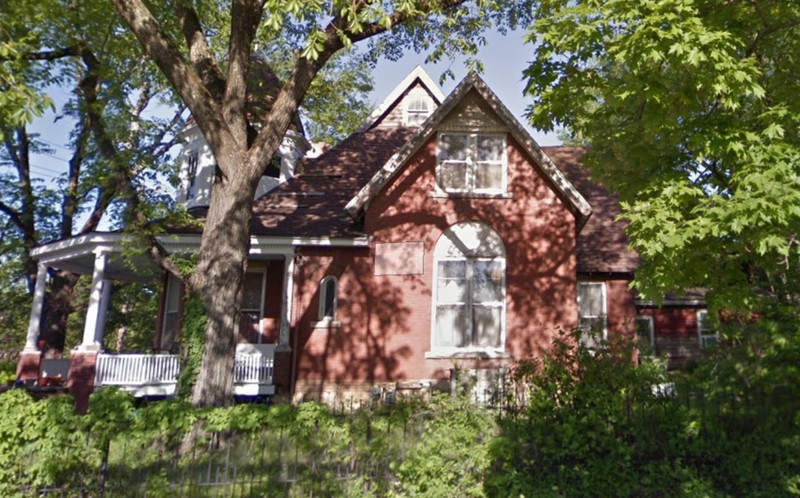Andrew Jackson (A.J.) and Mary Carrol Griffin House
Introduction
Text-to-speech Audio
The Griffin House, built around 1901 or 1902, served as the home to Andrew Jackson (A. J.) and Mary C. Griffin until 1916. The home symbolizes the wealth they amassed after establishing several prominent retail and wholesale businesses in Lawrence. The Griffins were also highly influential political, social, and activist leaders. The Griffins hired their friend Alexander Shaw, a longtime Lawrence lumberman, contractor, and politician (Shaw and A.J. Griffin served on the Lawrence city council), to build the exemplary Queen Anne house that fit the mold of a prosperous middle-class couple in a Victorian society.
Images
Griffin, Andrew Jackson (A.J.) and Mary Carrol House

Backstory and Context
Text-to-speech Audio
Andrew Jackson (A.J) Griffin, born in 1842, served in the Civil War and fought in several battles. He remained in the army until 1866 before returning to his home in Illinois; he married Mary Carroll, born 1847, in 1867. That same year, with very little money, the couple did what multitudes of Americans did during the nineteenth century—they headed west.
The Griffins came to Lawrence during a post-war period of rapid economic expansion and increasing population. The couple first operated a small farm before moving several times and working in several trades, such as hauling grocery freight to southern Kansas for a local wholesale grocery store and delivering stone for building the Southern Kansas Railroad. By 1869, A. J. operated a thriving lime, sand, and stone contracting business. His most significant contract involved the Bowersock Dam in 1877, which proved integral to Lawrence's industrial development. The success of that contract allowed Griffen to become the city's primary stone supplier, providing materials to several of Lawrence's most prominent industrial operations. In 1882, Griffin added a retail coal and wood yard, which also grew into a lucrative enterprise. And, in 1891, Griffin began to focus on the ice business, which proved exceptionally profitable.
Mary Carroll Griffin was not just A.J.'s wife; she was a strong business partner, and her community activism was profound, notably leading the women's suffrage movement in Lawrence. Mary Griffin also championed education and learning about other cultures, including Spain, France, and Japan.
By 1901, the young, poor couple that had arrived in 1867 had become one of the city's wealthiest and most recognizable couples, and the house they built further served to demonstrate it. The Griffins hired Alexander Shaw to build their dream home. Shaw served on the city council with A.J. Griffin and had completed many commercial and residential projects for the Griffins, including building the couple's first stone house. Shaw built a sophisticated Queen Anne house for the Griffins, consisting of beauty and an abundance of modern innovations such as modern steam heating, electrical lighting, plumbing, and luxurious windows that allowed for ample lighting and ventilation.
Mary Griffin had a reputation for hosting lavish parties, and the new house gave her a greater opportunity to impress. Many of her parties included journalists as invited guests; sometimes, the coverage ended up on the front page. The parties, house, and newspaper coverage speak to the status symbol provided by the home. Indeed, in Lawrence and throughout the nation, Queen Anne homes and other Late Victorian residences were popular among wealthy middle-class business owners during the style's greatest popularity from 1885 to about 1905; the homes stood as symbols of their owners' financial wealth and social standing.
While a status symbol and star attraction of Lawrence during its time, the Griffin home stands as one of the few luxurious homes within the East Lawrence neighborhood, comprised predominantly of working-class and lower-middle-class houses, ethnically-based churches, commercial industries, neighborhood schools, parks, and recreation areas. Less than three percent of the homes in East Lawrence are considered Queen Anne, and the Griffin home is generally regarded as the grandest.
Sources
Domer, Dennis with David Evans, Brenna A. Buchanan Young, Barry Shalinsky, and Rick Mitchel. "Registration Form: Griffin, Andrew Jackson (A.J.) and Mary Carrol House." National Register of Historic Places. kshs.org. 2020. https://www.kshs.org/resource/national_register/nominationsNRDB/DouglasCo_GriffinHouse_Listed_03172022.pdf.
Taylor, David. "Victorian Houses: A Guide To The Major Architectural Styles." Northwestern University. northwestern.edu. 1998. https://faculty.wcas.northwestern.edu/infocom/scndempr/school.html.
Wolfenbarger, Deon. “Historic Resources of Lawrence, Douglas County, Kansas.” National Register of Historic Places. kshs.org. 1997. https://www.kshs.org/resource/national_register/MPS/Historic_Resources_Lawrence_mps.pdf.
Google Maps: https://www.google.com/maps/@38.971531,-95.2324035,3a,52.6y,273.87h,104.74t/data=!3m6!1e1!3m4!1siomc_CIrWy0iWD1I9B7U_A!2e0!7i13312!8i6656?hl=en&entry=ttu
